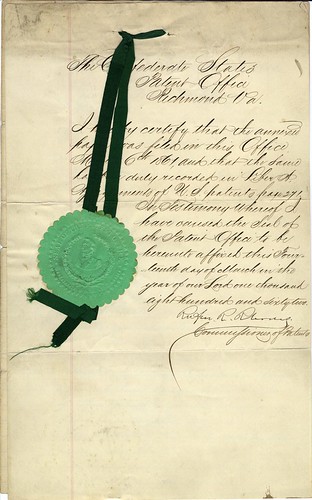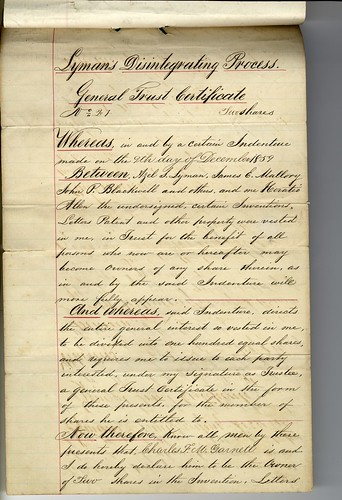A depiction of "A Rebel Guerrilla Raid in a Western Town" by the NYC-based political magazine "Harper's Weekly" in their issue from September 22, 1862. This publication can be accessed through the Littlejohn Collection.
The article in the Richmond Examiner of March 3, which has been generally copied into our papers, can not be read without the same emotion which is excited by the history of the French Revolution in 1793-94. The rebellion is becoming a domestic reign of terror. Nor can any man be surprised at the result. The inexorable logic of facts explains it. In a society which has assumed that to question the most atrocious injustice is so dangerous to social existence that the questioner may be properly lynched, what can be expected when it feels itself in danger from any cause? A man who carries concealed weapons will draw them upon every occasion of danger, real or fancied. A society which is founded upon injustice is necessarily barbarous.
Southern society is composed of the aristocracy who own the laborers, and the great middle class, more ignorant than any corresponding class in the world at the present day. Wealth and distinction are in the hands of the aristocracy. The middle class are poor and wretched; but they feel their wretchedness compensated by the fact that there is a servile race beneath them, and that by virtue of color they are the peers of the aristocracy. Hence, although not rich enough to own slaves, they support slavery, and they are the ready tools of the slave lords. Passionate, ignorant, prejudiced, ferocious---bred in a society where the unbridled will of rich proprietors is practically the sole law of a subject race--here are the elements of the most remorseless mob.
And to the reign of this mob the article in the Examiner, and similar articles in papers of the Southwest plainly point. No honorable and loyal citizen of the United States but must shudder as he contemplates the present position of men who have been faithful to their country, but who are at last exposed to the pitiless crowd which has been made sullen by the defeat of its armies, and has been inflamed by the appeals of leaders anxious to divert to the heads of the innocent the punishment of their own crimes. The editors of the Richmond Examiner would rather see John M. Botts hung to a lamppost than their own office gutted and themselves swung from its windows.
The reign of terror that has long existed in the rebellious section now openly appears. As in the blackest hour of the mob despotism in Paris, men are in danger of losing their lives upon suspicion of being suspected. “Now that the Government,” says the Examiner, “appears really in earnest in the suppression of treason, it becomes every citizen who knows a man or set of men inimical to our country and cause to point them out.”
This is the very tone of French terrorism. “The more the social body perspires,” said Collot d’Herbois, “the healthier it becomes.”
Here again is the Richmond Examiner: “The universal Yankee sympathizers dangling from as many lamp-posts would have a most wholesome and salutary effect. [sic]
It is but the echo of the French terrorist Barrere: “there are none but the dead who do not return.”
Our faithful fellow-citizens now in the power of the rebels, in whom desperation breeds ferocity, are exposed to these frightful perils. Their situation is but another stern appeal for the exercise of every power that can most speedily end the rebellion and secure actual peace. Already the bad bold men of the South are drifting into the terrible necessities of their stupendous crimes against human society. And how accurately does the French historian Mignet, describing the terrorist of the 93 and 94, describe the chiefs of the rebels of to-day in Richmond and the Southwest:
“Sprung from contentions, they wish to support themselves by it. With one hand they fight to defend their domination, with the other they lay the foundation of their system. They kill in the name of their principles. Virtue, humanity, the welfare of the people, all that is most sacred upon the earth, they employ to sanction their executions, to protect their dictatorship, until they are so worn out and fall.”
The article above was published in the March 22, 1862 issue of Harper's Weekly, which can be accessed through the Littlejohn Collection. Here I briefly discuss the reality of contempt for Unionists within the South, a group of people referred to above by Union publishers as "our faithful fellow-citizens." Although we must consider that the Harper's account is mired in bias and is consequently marked by a palpable air of hyperbole, it is useful for considering the social context of the era in which it was written, and remains a topic that merits review.
Yet, as we consider the American Civil War from this angle, it is essential that we re-evaluate the traditional dualist perspective often employed for analysis. It is quite easy to polarize this conflict into “North versus South” or “free states versus slave states”; however, in reality, this perspective often results in generalizations and over-simplification. Contrary to the popular image, “neither the United States nor the Confederate States was a genuinely united nation. Each had its naysayers, peace advocates, draft dodgers, and traitors.”1 Competing loyalties in the conflict blurred the lines of battle; moreover, that these "battle lines" were often drawn not by generals on a battlefield, but by civilians either practicing or victim to vigilantism on the home front.
While Harper’s Weekly likens the conflict to the French Revolution, a more apt comparison would be to the American Revolution, in that the central issue is drawn from a question of authority. Of course, this analogy is not one that the Union authors of Harper’s would appreciate. Putting aside the morality of the cause, it would be difficult, inciting problems of hypocrisy, for the Union to see itself as analogous to the British in this scenario. It is useful, therefore, to lay aside the issue of self-determination in this analogy and instead focus on the incidence of conservative loyalty within a “rebel” landscape. Just as eighteenth-century patriots condemned George III’s authority to pass laws presiding over them, nineteenth-century rebels condemned the power of Lincoln and of the free states in Congress. Drawing upon this analogy, we consider the treatment of Loyalists, or Tories, by the Patriots in the American Revolution. Their affiliation was, by most accounts, considered traitorous, and they were often harassed to varying degrees, from tarring and feathering to jailing to execution.2 While the latter was usually restricted to acts of high treason, it was not unusual for simple distaste for the Revolution to be met with suspicion. Not necessarily marked by acts of overt treason, this “kind of covert, sullen, uncooperative disaffection...that encouraged disrespect and mocked the capacity of the government to exercise its authority” was “identif[ied] and expose[d]” as seditious.3 Sometimes by the Court, and sometimes by vigilante Patriots, these men were put in their place.
A similar environment prevailed for Unionists in the South, where “residents suspected of Union sympathies suffered violent harassment by pro-Confederate residents and Confederate officials."4 Various punishments, including arrests and executions, were swiftly carried out on "suspicious" civilians, some of whom were women and children.
While conflict on the southern home front was certainly more common in some areas than others, in many regions, the reality was such that “ the war did not resolve itself into a neat argument between divergent political ideals or social allegiances.” 5 Dividing lines were drawn with regard to issues beyond political affiliation and exacerbated through problems of “cause and character, campaigns and stratagems...gender and minorities...personal vendettas, family feuds, [and neighborhood hooliganism.” 6 B. Franklin Cooling demonstrates the context of this intra-state conflict through a case study of guerrilla warfare in Tennessee and Kentucky, in which “poorly defined bands and individuals...broke off from authority and waged virtually uncontrolled mayhem, often without regard to allegiance or loyalty, much less legal controls of either the Confederacy or the Union.” 7 A community’s political position in the conflict may have been tied up in a number of issues that had little to do with geographic latitude. Secession was by no means a unanimous decision, and each state--and the communities within it--had its dissenters.
The recognition of Union loyalties within the Confederacy became apparent very early on, and this awareness was followed by an effort within the Confederate States to monitor and control communities and objects of suspicion within them. In his analysis of guerrilla violence during this period, Sutherland found that “the Rebels employed a variety of means to keep Unionists in check, including intimidation by Confederate soldiers, militia, conscription and impressment agents, and watchful secessionist neighbors; but nothing was as effective in controlling dissidents as the threat of retaliation by Rebel guerrillas.” 8 Amid the chaos of the war, very little justice was uniform, and decisions about the severity of punishments were often made by individual militias or home guard units without orders pertaining to the crime committed. In southern communities, where the majority of men were deployed, there were very few control agents who had the ability to maintain order; the Confederate Home Guard, charged with this exact duty, suffered from a dire lack of communication with any government bodies and therefore often resorted to unsanctioned methods of imposing control. And “without a shred of Confederate support, the militia commanders were insubordinate, oftentimes making their own policy and countermanding orders from the governor.”9 Among Southerners for whom secession was a disappointment, there was a sense of fear provoked by the indiscriminate antics of the Confederacy and its allies. From the Confederacy’s inception, there was a feeling of paranoid suspicion that can now be likened to Soviet-era McCarthyism. In both cases, the anomie that resulted from desultory suspicion and libel instigated a new war of contention on the home front, into which an entire community was conscripted, and for which no uniform was required.
This type of chaos, Cooling argues, “constituted the real Civil War”10 in many cases, and illustrates a different nature of the conflict that is often forgotten.
2 Robert McCluer Calhoon,The Loyalists in Revolutionary America, 1760-1781 (New York, Harcourt Brace Jovanovich, 1973), 401.
3 Robert McCluer Calhoon,The Loyalists in Revolutionary America, 1760-1781 (New York, Harcourt Brace Jovanovich, 1973), 404.4 Lesley J. Gordon, “‘In Time of War’: Unionists Hanged in Kinston, North Carolina, February 1864,” in Guerrillas, Unionists, and Violence on the Confederate Home Front, ed. Daniel E. Sutherland (Fayetteville: University of Arkansas Press, 1999), 48.
5 Daniel E. Sutherland, “Introduction: The Desperate Side of War,” in Guerrillas, Unionists, and Violence on the Confederate Home Front, ed. Daniel E. Sutherland (Fayetteville: University of Arkansas Press, 1999), 6.
6 B. Franklin Cooling, “A People’s War: Partisan Conflict in Tennessee and Kentucky,” in Guerrillas, Unionists, and Violence on the Confederate Home Front, ed. Daniel E. Sutherland (Fayetteville: University of Arkansas Press, 1999), 114.
7 Ibid.
8 Daniel E. Sutherland, “Introduction: The Desperate Side of War,” in Guerrillas, Unionists, and Violence on the Confederate Home Front, ed. Daniel E. Sutherland (Fayetteville: University of Arkansas Press, 1999), 8.
9 Donald S. Frazier, “‘Out of Stinking Distance’: The Guerrilla War in Arkansas” in Guerrillas, Unionists, and Violence on the Confederate Home Front, ed. Daniel E. Sutherland (Fayetteville: University of Arkansas Press, 1999), 158.
10 B. Franklin Cooling, “A People’s War: Partisan Conflict in Tennessee and Kentucky,” in Guerrillas, Unionists, and Violence on the Confederate Home Front, ed. Daniel E. Sutherland (Fayetteville: University of Arkansas Press, 1999), 114.












